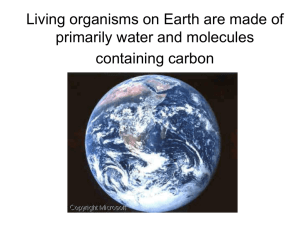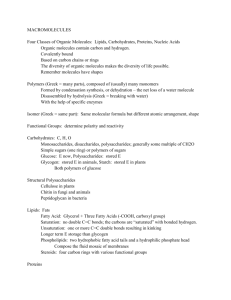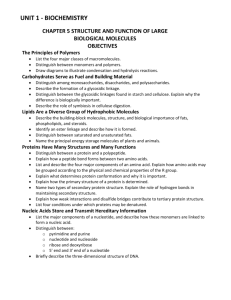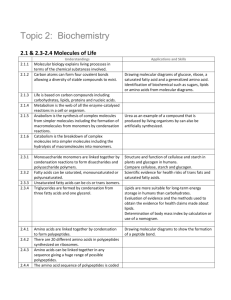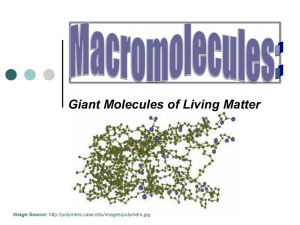Biological Molecules
advertisement
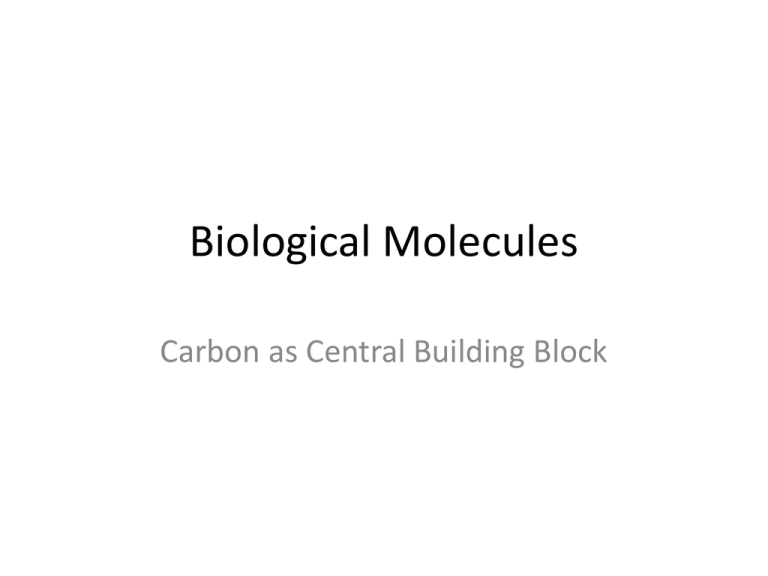
Biological Molecules Carbon as Central Building Block Carbon Compounds • Organic compounds – primarily Carbon atoms – Large, complex molecules essential for life – Contributes to diversity of life • Carbon bonding – Has 4 valence electrons – Can form single, double, or triple covalent bonds – Can form straight or branched chains of itself – Can form rings of itself Palmitic acid Functional Groups • Influence characteristics of molecules – Make polar with addition of charged entities • Affect chemical reactions molecules undergo – Allow bond formation between molecules • Some of these groups are – – Hydroxyl – Carboxyl – Phosphate – Amine (R-OH) (R-COOH) (R-PO4) (R-NH2) Functional Groups in Action Large Carbon Molecules • Monomers – Small, simple molecules – Amino acid, fatty acid, nucleotide, monosaccharide • Polymer – Monomers join via condensation reactions • Polypeptides • Disaccharides – Polymers break down with hydrolysis reaction • Macromolecules -- Formed from large polymers -- Protein, lipids, nucleic acids, carbohydrates Polymers & Monomers A= adenosine; T=Thymidine; G= guanosine; C= cytosine Energy Currency • Compounds store energy in chemical bonds • Certain ones’ overall structure stores energy – ATP (Adenosine triphosphate) – NADH (Nicotinamide adenine dinucleotide) – NADPH (Nicotinamide adenine dinucleotide phosphate) – FADH2 (Flavin adenine dinucleotide) ATP Molecules of Life • Carbohydrates – (CH2O)n general formula n = 3–8 monosaccharides – Hundreds of glucose monomers make glycogen (animals) or starch & cellulose (plants) • Proteins – Composed of amino acids (C, H, O, N et al) – 20 essential amino acids, differ in –R groups – Amino acids joined via peptide bond between amino side of 1 & carboxyl side of another – Enzymes are protein catalysts Molecules of Life, continued • Lipids – Large, nonpolar organic molecules – Higher ratio of C & H atoms to O atoms than sugar • Types – Fatty acids (12-28 C chain with –COOH group) – Triglycerides (3 fatty acids attach to glycerol) – Phospholipids (2 fatty acids attach to phosphate on glycerol’s 3rd carbon) – Waxes (long fatty acid attaches to long alcohol chain) – Steroids (Four fused carbon rings + functional groups) Molecules of Life, continued • Nucleic acids – Store and transmit important info in the cell • DNA: determines traits & directs cell activities • RNA: stores/transmits info from DNA • Composed of nucleotides – Adenine, guanine, cytosine, thymine or uracil • Made of 3 compartments – Phosphate group – 5-C sugar [(deoxy)ribose] – Ring-shaped nitrogenous base

